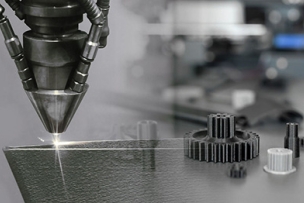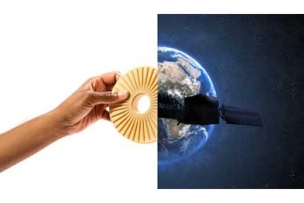This category includes technologies such as selective laser sintering (SLS), direct metal laser sintering (DMLS), direct metal laser melting (DMLM), selective laser melting (SLM) and electron beam melting (EBM). All these technologies use polymer or metal materials in a powdered form. A powerful laser is flashed on the individual powder particles to sinter or melt them ultimately to form a strong bond with the adjacent particle. Thus by flashing the laser on the required particles according to the geometry, the object is formed.
MATERIAL JETTING
Material Jetting processes operate quite similarly to how a two-dimensional inkjet printer works. Liquid photosensitive thermoplastic material is filled in multiple print heads above the build platform. The material is then dispensed onto the build platform in the form of droplets. After each layer, the material is then hardened by exposing it to UV light, thereby building the part layer-by-layer.
BINDER JETTING
Binder Jetting is similar to material jetting but it uses two materials in place of one. A powder material sits in a tray and the binder material is sprayed onto it in a pattern to hold the powder together. A wiper brushes another layer of powder on top and the process is repeated.
SHEET LAMINATION
Sheet lamination is an umbrella term for two techniques, namely:
Laminated Object Manufacturing (LOM)
LOM is used for 3D printing products using sheets of paper which are joined together using adhesive. This process uses a cross-hatch method so the completed part is easy to remove. Objects 3D-printed through LOM are only used for aesthetic purposes and are not fit for structural use.
Ultrasonic Additive Manufacturing (UAM)
UAM is similar to LOM but differs in the material used. Here, metal sheets are used in place of paper sheets and they are joined together by welding in place the adhesive for LOM. This technology can 3D print with metals such as aluminum, copper, steel, and titanium. As the metals don’t need to be heated, this process requires relatively less energy.
DIRECTED ENERGY DEPOSITION
In a Directed Energy Deposition (DED) process, a nozzle holds the material in a wire form, known as a feed, that moves across multiple axes. An electron beam projector then melts the feed as it moves across while tracing the object geometry. As DED uses a laser, this process is also called Laser Engineered Net Shaping, 3D Laser Cladding, Directed Light Fabrication or Direct Metal Deposition. This technology is used popularly for metals.
ECOSYSTEM OF ADDITIVE MANUFACTURING
Additive manufacturing technology requires an entire ecosystem around it to function efficiently. Below are the four components of the ecosystem.
CAD AND SLICING SOFTWARE
Software forms an integral part of the 3D printing ecosystem. Multiple software are required to complete the 3D printing process. These include CAD design softwares like Catia, Creo, Fusion 360, and Solidworks to create the 3D model. Slicing software takes the design file and prepares it for the printer. New cloud-based options such as MakerBot CloudPrint™ add features like remote printing and monitoring, team collaboration and print queuing, and reporting for management.
MATERIAL
For additive manufacturing to make sense for your applications, material choice is crucial. Different AM technologies offer different ranges of materials. Some very specific and some more broad. The materials can be polymers, metals, composites, etc. (more on this in the Materials section of this article).
3D PRINTER AND SUPPORTING ACCESSORIES
This is where the actual 3D printing process takes shape. Here, the design and associated settings combine to create the three-dimensional object. The final file is sliced and the print is started. In addition to the printer itself, other hardware accessories may come into play. On the MakerBot METHOD®, for example, there are 6 modular extruders that can quickly swap in and out – each optimized for a specific material set. Another accessory might be a filter attachment like the Clean Air™ System for METHOD.
POST-PROCESSING
Almost every 3D printed object requires some level of post-processing and so this also forms an essential part of the 3D printing ecosystem. Post-processing techniques range from basic support removal, sanding, and painting to more complex processes like debinding and sintering for FDM metal prints which results in a solid metal part. Different technologies have different requirements as well. Powder-based systems require the removal of the print from a bed of powder, while resin-based systems require washing harmful resins and post-curing.
MATERIALS USED IN ADDITIVE MANUFACTURING
POLYMERS
Polymers were the very first materials to be developed for 3D printing. FDM 3D Printers use filament on spools like those manufactured by MakerBot. MakerBot manufactures and sells high-quality polymers like ABS, Nylon, Nylon Carbon Fiber, PC-ABS, ASA, PETG, SR-30, PVA and more. MakerBot Materials for METHOD are manufactured to exact diameter and quality specifications and thus result in a successful output every time.
Polymers are also used as resins in Vat Photopolymerization type of 3D printers and as powders in powder-bed fusion type of 3D printers.
COMPOSITES
Polymers can also be mixed with other materials to gain additional attributes. Carbon fibers and glass fibers are two popular examples of this, as well as electrostatic discharge (ESD) materials. These are most commonly found in the FDM space at the moment.
METALS
Some of the most popular metals are now capable of being 3D printed. However, new materials are constantly being qualified for use in additive manufacturing. Some of the popular 3D printing metals are Stainless Steel, Titanium, Nickel, Chromium, Copper, etc. Metals are used in DMLS, SLM, DMLM, Sheet Lamination, DED 3D printing technologies, and now – with bound metal filament available – FDM.
CERAMICS
Ceramic is a popular material generally associated with pottery or kitchen items. But it is also widely used in industries because of its ultra-high heat tolerance. As a result, companies have developed ceramic materials for 3D printing in FDM, SLA, and Binder Jetting technologies.
Some common ceramic materials are boron carbide, aluminum nitride, zirconia barium titanate, lead zirconate titanate (PZT), glass, tungsten carbide, zirconium carbide, and silicon nitride.
CONCRETE
Concrete is one of the newest materials to be introduced in 3D printing to cater to the construction application. The use of this material is quite limited right now but shows huge potential in the coming future.
BIOINK/BIOMATERIALS
Bioink is a material used to produce artificial tissues with the help of 3D printing technology. Bioinks are even considered as the harbinger of the golden age of healthcare in the coming years. A bioink is any natural or synthetic polymer selected for its biocompatible components and favorable rheological properties. These characteristics temporarily or permanently support living cells to facilitate their adhesion, proliferation and differentiation during maturation.
ADDITIVE MANUFACTURING IN INDUSTRIES
Additive manufacturing is used to create a wide range of products across a growing number of industries, including:
AEROSPACE
Additive manufacturing is the ideal technology for the aerospace industry due to its ability to optimize the part design. This helps in reducing the overall weight of the system which is highly crucial in the aerospace industry.
AUTOMOTIVE
The automotive industry also benefits from the capabilities of additive manufacturing like weight reduction, topology optimization to reduce system weight in motorsports and generative design to innovate new parts and part consolidation to build direct assemblies.
EDUCATION
3D printing in education is widely popular. With the growth of STEM education, 3D printers are used in schools to quickly develop learning models for concepts. It also offers students in technical institutes first-hand experience of additive manufacturing technology typically used in the real world.
MEDICAL/DENTAL
The medical sector is an early adopter of 3D printing. Since the early days of additive manufacturing, doctors have used the technology to 3D print pre-surgical models, prosthetics, titanium implants, and multiple dental products like aligners, crowns and bridges, etc. Researchers are also using 3D printing to print organs. Although, this is still in the R&D phase, it will be a reality in the coming decades.
CONSTRUCTION
3D printing in construction is a rapidly growing trend globally. Large construction companies are now experimenting with 3D printed buildings.
FASHION/APPAREL
3D printing technology is also used to 3D print apparels and footwear, like sports shoes. 3D-printed jewelry has also gained popularity over the past few years.
ADVANTAGES OF ADDITIVE MANUFACTURING
Additive manufacturing boasts certain unprecedented advantages for the manufacturing industry. While it started out primarily for prototyping, additive manufacturing can be used for end part production when the most complex geometries are required. Similarly, AM can be used to achieve a level of customization not imagined before, thus resulting in bespoke products. This has a direct impact on the efficiency of the part and of the overall system.
Additionally, the 3D printing technology is a less-waste technology saving material costs as well as associated logistics, storage and warehousing costs.
Due to its on-demand manufacturing capability, 3D printing is also suitable for spare parts management, thus decreasing the dependence on investing in huge warehousing facilities. Any spare part needed can be manufactured on demand.
Finally, 3D printing has the ability to incorporate data and new-age technologies like artificial intelligence and machine learning into the manufacturing, digitizing the manufacturing capability. This helps in improving the efficiency of manufacturing, identifying the flaws and building self-correcting systems.
SUMMARY
Additive manufacturing has come a long way over the past 30+ years. Today, there is a wide range of technologies that fall under the umbrella of the term additive manufacturing. In our evolving society, each of these technologies have a place. As AM technologies become more affordable, versatile, and efficient, industries will continue to bring these useful tools to their teams whether in the design lab or on the manufacturing floor, or perhaps someday even on the surface of another planet.
Previously Featured on Makerbot's blog.



Talk to Us!
Leave a reply
Your email address will not be published. Required fields are marked *